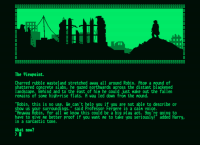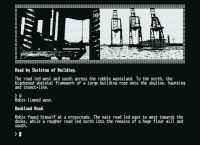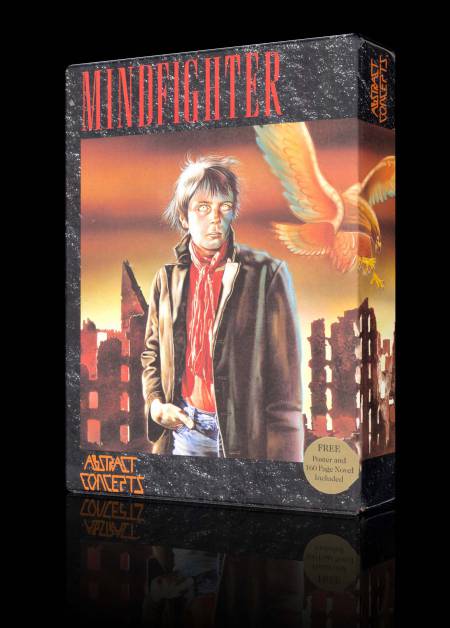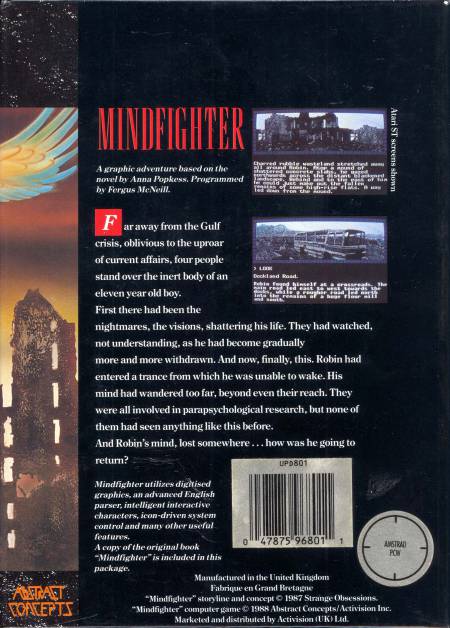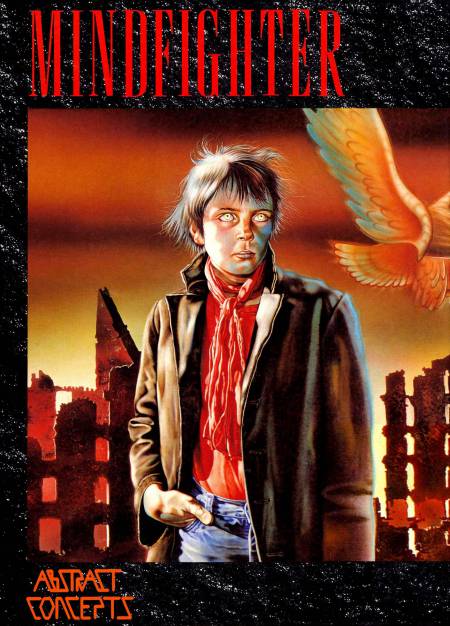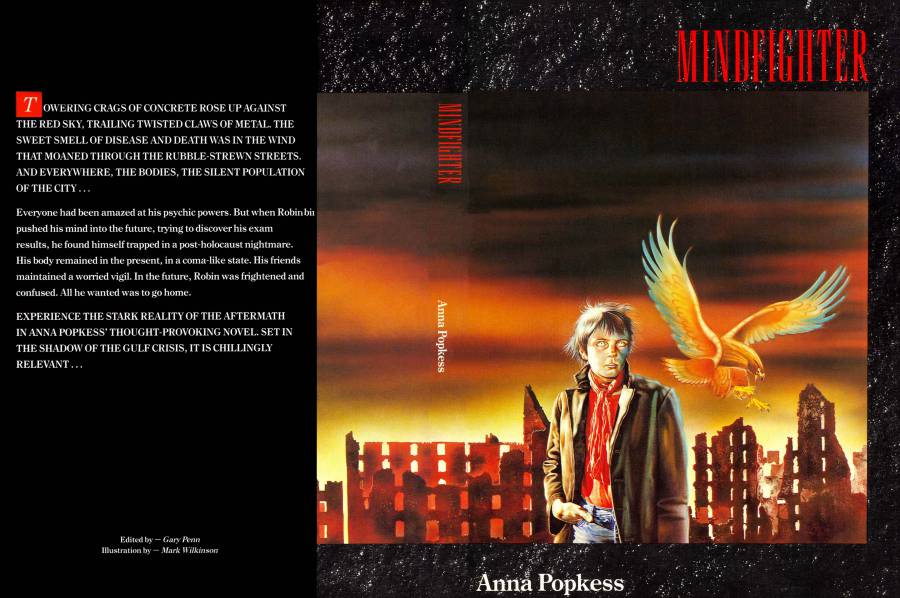Table of Contents
Mindfighter
| Company | Abstract Concepts / Activision |
|---|---|
| Distributor | Abstract Concepts / Activision |
| Production team | Programming: Fergus McNeill |
| Year | 1988 |
| Packaging | Carton box 15,70 × 21,90 × 3,30 cm |
| Compatibility | PCW 8256 - PCW 8512 - PCW 9512 |
| Peripherals | Keyboard |
| Loading | CP/M+ |
| Gender | Conversational Adventure |
| Language | English |
| Price | England: £24,99 |
| State | Preserved |
Screenshots
Description
Abstract Concepts' Mindfighter is a graphical conversational adventure based on life in Southampton after a nuclear holocaust. The player takes on the role of a young man who, if he manages to finish the game, becomes the savior of civilization as we know it. To help understand the game a 150 page book is included.
The difference in this game, says Abstract Concepts, is that each character has emotional and physical characteristics that make the game change every time you play. Even the weather can affect the development of the story. One thing puzzles us: how can you tell the difference between pre-Holocaust and post-Holocaust Southampton?
Interestingly, even though the PCW is not the primary target machine for Mindfighter, Abstract Concepts does all of their program development on the PCW and then ports it to the Atari ST and other machines.
First steps with Mindfighter
First, it's produced by Fergus McNeill and Anna Popkess, who many readers, especially those who enjoyed the satirical adventures of Delia 4, are already familiar with. Anna was a new recruit to Delta 4 and formed her own company, Abstract. Concepts, who in turn produced Mindfighter.
Second, the game is programmed using a new creation system called SWAN and Delta 4 rose to fame by turning The Quill, Robin of Sherlock, The Boggit and others into nifty games. So it may not surprise you to hear that SWAN was produced with no little help from Gilsoft's Tim Gilberts.
In fact, SWAN has several Quill-like features, which they'll discuss/alter well, but adds a lot more, including interactive characters and an improved parser. This also features an icon system menu for loading, saving, etc. There is also an Oops! to go back one move. oops! It doesn't work on some machines due to memory limitations. RAM save and restore are also included.
Finally, the game is interesting because it shows how committed Activision is to supporting the adventurous side of the market. In a press conference, the company stated its commitment to “storytelling”, so it was hoped that the Abstract Concepts collaboration would be successful and produce many more games.
Mindfighter has some disappointing features, but it emerges as a challenging game with a powerful setting despite its drawbacks. He's resourceful and deals with the snag first when we take on the role of Robin, a young man with psychic powers stranded in post-Holocaust Southampton.
SWAN, while a new system, is still quite primitive compared to the Level 9 and Magnetic Scrolls programming environments. For example, you walk up to an old window in a dilapidated building and enter EXAMINE WINDOW, whereupon the program responds ROBIN CAN'T EXAMINE THAT. You also can't examine the building, or indeed many of the other objects you find during your travels.
These objects are, of course, part of the landscape. Level 9 fixes this by saying something, like WINDOW: THAT'S JUST SCENARIO and Magnetic Scrolls could REALLY say. IT IS USELESS TO PLAY WITH THE SCENARIO. But SWAN just puts his foot down. The truth comes out if you enter EXAMINE QWRT. Whereupon the program replies ROBIN CAN'T EXAMINE THAT again. Of course it can't, because it doesn't exist. The sad truth is that the program, like many older systems, doesn't tell you what words it doesn't understand.
The YOU CAN'T DO THAT type of message is the absolute death of atmosphere in a good adventure. Suddenly, the analyzer drags you out of the world of fantasy. SWAN was expected to be updated and made a little more user friendly in the future.
The other drawback of Mindfighter is the map. Relationships between locations are often illogical in real-world terms - it's very difficult to circle continuously moving EAST in real life, but you can do it in Mindfighter. Mapping actually becomes quite enjoyable, but you can get confused and frustrated at first unless you get out the pencils.
Introduction
Follow these translucent eyes, this haunting emerald gaze. They will make you see what you have never seen. The closest future, the most moving horror. An Earth that no longer has anything human. It is the flight to hell that awaits us in the post-nuclear age. But it's not too late. If you manage to guide the hero in this fantastic adventure, everything can change.
These eyes are Robin's eyes. He is only eleven years old but he can handle anything. His physical strength is limitless. Orphaned at eight, he is taken in by Professor Fergere, a parapsychology teacher, and later joins the team of gifted people who fuel the professor's experiments: Mayhew, Harry and Allison. Thus begins the tale of Anna Popkess, written like the play in difficult, literary English inaccessible to gossips. Others will be delighted with this original text built in the purest tradition of fantastic cinema, close to the Exorcist, to the Curse. or the Village of the Damned. These children, angels or demons, are capable of both the worst and the best. Their latest invention is metamorphosis: they transform, by the power of their minds alone, into an eagle, a mouse, or a lion.
Robin went even further, he left in the future, a year later. Only one year, but in the meantime nuclear war has broken out. Men have been transformed into emaciated beasts fighting savagely for survival under the control of a ruthless and cruel dictatorship: the System. This is where the adventure begins. Unlike most adventure games, the story doesn't end where the game begins. The entire story is told in the book, and all you have to do is relive the story on screen. Robin is projected into the future, but he is also in the present, in the hospital, surrounded by his friends and the professor he sees in his eyes. Helped by his advice, he will try to defeat the System and avoid the disaster that happened a year before because of him… An icon table can replace the game at any time to save the game, check Robin's physical and mental state, or delete all the images on the screen. The game counts very few of them anyway, disguising the horrifyingly specific descriptions. The opening scenes, as you wander through the ruins of Southampton, are sordid: three wild-eyed beings beat a dog to death, whose howls break the silence. You yourself swallow a rotten dog so you don't starve.
Don't forget your power to change shape; transformed into a bird of prey, you will enter the System files, jealously guarded in the heart of a palace inaccessible to ordinary mortals. This is your first victory against the System. Eye, here the slightest deviation is fatal. Somewhere in the city, a radioactive gas still hangs; elsewhere, you trip over a stone to fall into a pile of half-dead, half-alive meat and die in the stench of decomposing bodies. Monstrous, terrifying… But this carnage will not be: you are Robin, and the fate of the world is in your hands.
Starting
You see, there's an eleven-year-old boy named Robin who happens to be incredibly psychic, so much so that he can not only morph into eagles, rats, and other non-human forms, but he can also project himself into the future. He almost by accident finds himself in a Britain of the future where, after a nuclear bombardment, the System tyrannizes the hungry remnants of Southampton's trillions, whose only redeeming feature is their ability to glow in the dark. Under the guidance of Professor Fergere, his mentor, Robin's task is to “change the future by preventing a nuclear war”.
The book simply abounds with such immortal lines as “It was the anniversary of the day Nick raped Alison's mother,” or “I'll save the world, trust me.” Fortunately, the game itself is a bit more compelling.
The atmosphere is very strong and this is conveyed partly by the text and partly by the graphics. The latter appear and disappear and are both unusual and effective. The scenes represent a landscape completely devastated by nuclear war: dark silhouettes of ruined buildings, streets packed with the dead and dying, a disconcerting silence everywhere.
As Robin, you roam the streets collecting useful items along the way and are aware that one of the System's guards, led by the cruel Yabushi, could attack you at any moment. You can retaliate, of course, but as an eleven-year-old sucker, your chances of victory are slim.
As you explore this dying world, you'll find the bodies of your psychic friends, like the innocent and vulnerable Alison Whitley. Fortunately, there are some less dying characters, like the journalist Jimmy or James, as he preferred to call him in his previous incarnation as a headline writer for the Sun. Now it appears that he is the leader of an underground resistance movement.
If you look at your score, you will see a brief description of Robin's emotional state, such as sad, sad… or sad. It is not surprising!.
Conclusion
In addition to the usual commands such as INVENTORY, BROWSE, etc., a system of icons for loading, saving, printing (among other functions) accompanies the main game and can be accessed simply by pressing RETURN. The text can be read in short or detailed mode and the images can be turned off if you get tired of them. As with many adventure games, there is an OOPS feature that allows you to retrace your previous (usually fatal) moves.
Unfortunately, some of the in-game responses are unimaginative - YOU CAN'T DO THAT, for example, it gets a bit monotonous after a while. Still, the game is strong on atmosphere and, like you could wait, there's a set of problems that should keep you baffled well into the inevitable holocaust itself.
Mindfighter has a strong setting, and despite the drawbacks, it's still a challenging and fun game, if a bit frustrating at times. Since Infocom and Magnetic Scrolls were leaving the Amstrad market, games like these SWAN-like systems could represent the future of the 8-bit adventure market, and in particular the Amstrad 8-bit adventure market.
Packaging
Cover
- Original cover
Here is the original cover.
- Retouched cover
Its measurements are: Height 15.70 x length 21.90 cm.
Manual
Below is the manual printed on plain black and white paper. Its measurements are: Width 14.00 x Height 19.80 cm.
Discs
Labels
Custom labels to print. Over the years due to their use, the labels are damaged and lose their color and quality. Now we try to adapt the closest thing to the extent of our possibilities, the labels so that they can be printed and replaced or for those of you who work with a copy of the program and preserve the original disc. Measurement in 3“ height: 7.00 cm - width: 7.10 cm. The first image corresponds to the original game label, the second is the same modified label to replace the broken one.
Extras
Book supplied with the game
Its measurements are: Width: 31.60 cm x Height 21.00 cm.
Map
Then we leave you with the map to make it easier for you to finish the game.
Poster
Here you have the poster. Measures: Width 42.10 cm x Height 29.80 cm.
Advertising
Some advertisements for the game in high-circulation magazines of the time.
Dowloads
Game
The disk images, disk, have been obtained from the original version of Mindfighter, have been recorded and verified.
- Mindfighter (Compressed .DSK file in ZIP format)
Manual
Below you can download the Mindfighter game manual or view it online. The manual sheet measures: Width 14.00 cm x Height 19.80 cm.
- Mindfighter English Manual (PDF file)
Book
The book page measures: Width 15.00 cm x Height 21.10 cm.
- English Companion Book to Mindfighter (PDF file)





